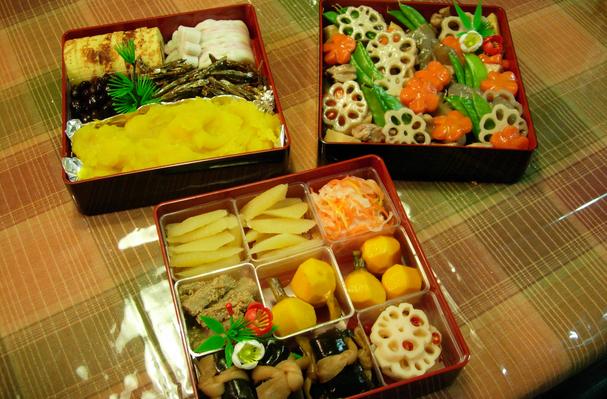Osechi
About
Osechi ryori is the traditional cuisine that is served on New Year's Day in Japan. Osechi ryori was originally a way for housewives (and their families) to survive the first several days of the New Year, when stores throughout Japan were closed. The foods that make up osechi can be prepared in advance and then sit out in a cool area for a few days without spoiling. Most often everything is placed in compartmentalized lacquer boxes that are stacked in layers.
Many of the food items represent prosperity, good fortune and health. The basic components are the same, but regional differences are reflected in the sweetness or saltiness of the flavoring and the use of local ingredients.
One thing to keep in mind when looking at osechi is that presentation is very important. You may notice a pleasing balance of colors. What may be harder to notice, though, is the efficiency with which each layer is packed. The more elaborate osechi will have vegetables arranged in ornate designs, representing seasonal shapes such as pine cones and plum flowers.
Osechi-ryori components:
Kazunoko (herring roe) - tiny yellow fish eggs. Like the tobiko you often find at sushi restaurants, kazunoko have a bite or crunch to them, however, the eggs are not loose. They are marinated in a broth of dashi, sake and soy sauce.
Kuromame (black beans) are soft and quite sweet, although you may notice a bit of soy sauce flavoring.
Gomame (also known as tazukuri) are small sardines that have been dried and then finished in a sweet sauce of sugar, mirin, soy sauce and sake. These are rich in calcium and yes, you can eat the head.
Kombumaki are nothing more than the umami-rich kombu rolled tightly and bound shut with a ribbon of gourd strip (kampyo). Often kombumaki are stuffed with salmon. This is also cooked slowly in dashi, mirin, sugar, and soy sauce.
Datemaki looks like the tamago-yaki (egg custard) you often find in a bento box, but here it's made with a fish paste and has a sponge-like texture. It's quite sweet.
Sweet potatoes and chestnuts are the base of kurikinton, which can look something like yellow mashed potatoes.
Kamaboko, a dense cake of fish paste, is red and white (traditional New Year's colors). You can often find thin slices of this on your soba.
Another red-and-white food you'll find is called namasu - typically daikon and carrots pickled in vinegar.
For vegetables, look for gobo (burdock root), often dressed with sesame. Also lotus root, carrots, shiitake mushrooms and pea pods.
Konnyaku (devil's-tongue starch) and fu (wheat gluten) will also be sprinkled throughout the stacked boxes.
For seafood, shrimp (representing long life) and sea bream (for auspicious fortune) are most typical.










